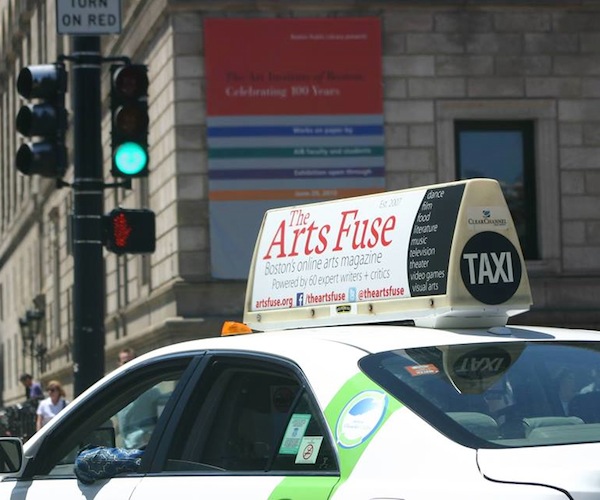Fuse Commentary: Arts Criticism Isn’t Free — Support The Arts Fuse!
Those who care about the future of American arts and culture should financially support this magazine and other valiant efforts to articulate the significance of the arts beyond their value as consumer goods.

Kenneth Tynan — he believed that something should be at stake for arts critics. And there is — the health of the culture.
By Bill Marx
A lot has been written about how hard it is for artists to make a living today. An excellent piece in the Jacobin entitled “Culture Isn’t Free” recently summed up the situation nicely: “In a post-Napster era, artists of all stripes face the expectation that the fruits of their labor should circulate for free, both on and offline, and when revenues from creative work do trickle in, they rarely amount to a decent wage.”
But what about those who write seriously about the arts? In the post–Huffington Post era, critics have to face the pernicious expectation that quality arts journalism should cost nobody nothing. Not a lot has been written about the economic plight of arts critics, though Scott Timberg takes up the issue — and its dire cultural side effects — in his excellent Culture Crash. The mistaken impression that every opinion about the arts is of equal value means that anybody can cover the creative waterfront, while it relieves media organizations of feeling that they should pay for the contributions of knowledgeable reviewers and reporters who challenge popular taste. “I enjoy testing people,” boasted the superb critic Kenneth Tynan, “exposing them to ideas/experiences that will for them reassess the values by which they live, either politically, theatrically, or sexually.” Dissent tends to be expensive: it is so much cheaper and easier to pay a pittance to critics and arts reporters who see it as their supportive duty to reassure readers and arts institutions that all is always well. For critics anxious to keep their gigs and please their editors, the business of arts coverage comes down to being good for business.
In a commentary on Poynter.org, Matt DiRienzo asks an important question: “Why aren’t we focusing more on the preservation and well-being of individual journalists instead of the companies that have traditionally employed them or we hope will in the future?” Writers, particularly those who work for high-profile online publications, are beginning to realize that they will have to organize in order to receive “a decent wage”: contributors to Salon (including arts critics and reporters) announced a week ago that they are following in Gawker‘s footsteps and joining the Writers Guild of America, East. In a letter, the Salon writers argue that it makes sense to organize with the WGAE because it is “an opportunity to help establish standards and practices in Internet journalism. It’s an exciting moment for our field, and we want Salon to be at the forefront of change.”
When it comes to Internet journalism and arts coverage in Boston, “standards and practices” among our sizable media organizations, such as The Boston Globe, WGBH, and WBUR, are pretty low. From what I can tell, their rate of pay for freelance arts writing on the web is peanuts — contributors receive the same fee I was handed per article from these same journalistic enterprises in the 1990s! (Of course, interns were and are exploited for free.) Our big media, public and for-profit, use the arts when they want to generate cash or make a publicity splash, but the editorial and financial resources — online and off- — committed to covering the wealth of arts and culture in the area are meager, aside from the mainstream media dependably finding the shekels necessary to follow the doings of our major cultural institutions.
Along with organizing, there are other ways to pay for first-class journalism. DiRienzo argues that “better technology and networks are needed to support a freelance economy in which independent journalists can earn a living. Crowdfunding and the concept of journalist-as-an-API (in which freelance content might live on and be monetized by a number of different platforms) are promising starting points.” The Arts Fuse is proud to be among those starting points, committed to creating a fair freelance economy. Donations to the magazine during our summer fundraiser will help us get the word out so we can maintain the magazine and pay for the excellent work contributed by our writers, a number of whom have written for the contracting arts section of the Boston Globe and the defunct Boston Phoenix. We provide a home for their expertise and skill.
Why should you care? Why not let arts journalism go down the drain? There will still be plenty of arts and culture, though technology is making it increasingly difficult for artists to make a living. Yes, lean staffs and shrinking column inches mean less arts coverage. But the larger point is that online media’s softening of “standards and practices,” epitomized by the jettisoning of critical discrimination, is a disaster for arts, artists, and culture. Journalism’s increasing dependence on the language of marketing strengthens the stranglehold of an increasingly corporatized, homogenized culture. Blurb-crazed critics and cheerleader arts reporters are not really journalists — they are an extension of a media company’s branding campaign. The arts event inevitably chosen to be praised (access = publicity) is the kind that makes readers/listeners feel good about themselves and where they learned about it. Cultural journalism no longer means making independent judgments or knowing enough to articulate whether the art is any good or not. It means saying the right things the right way … with nary a discouraging word. The traditional notion of accomplished arts criticism and journalism as a space where off-the-beaten-path stuff is treasured, where naked-as-jaybird emperors and empresses can be called out, is losing out to the profit that comes with nonstop enthusiasm.
Debate about the declining quality of arts and culture coverage is rare in the mainstream media. (There are endless self-congratulatory confabs about the state of political coverage.) Professional criticism of the arts continues to fade away (e.g., the rise of capsule critiques, best list-o-mania, editorial calls for only posting admiring reviews, etc.), with the plethora of dumbed-down reviews either mimicking PR material or making cowardly bows to commercial pieties and feel-good platitudes. (Local TV news outlets, as well as MSNBC, Fox, and other cable giants, ignore the arts — except to make an ideological point or to report movie box office results.) Two years ago I explained why arts coverage had become so bland at the Boston Globe, WGBHArts, and WBUR’s Artery. I will not repeat my arguments here, though I will note that the drive toward banality is progressing more quickly than I had originally posited, perhaps because this puerility benefits the large, play-it-safe cultural organizations. It also diminishes the chances of survival for innovative arts endeavors on the margins.
When the media’s cultural agenda is driven by marketing rather then individual taste, the inventive, the fresh, and the dissenting inevitably lose out. Access to big media and technology is the key player in the branding game. Truly edgy artists and organizations do not have the high roller connections or dollars to garner media attention. And they will be outgunned in terms of resources when it comes to harnessing the influence of social media.

Please keep the Arts Fuse strong and support the magazine.
Why can’t arts coverage be as incisive and opinionated as media’s treatment of politics, sports, or business? Why must the arts be patronized? The Arts Fuse is a response to the tidal waves of innocuousness — the magazine’s mission is to cultivate a thoughtful dialogue about the arts, to explore how culture reflects (and questions) what we think about ourselves and the society we live in. Just this month, Arts Fuse offered two fine examples of critical point/counterpoint. A give-and-take about the current Thomas Hart Benton exhibition at Salem’s Peabody Essex Museum presented clashing points of view (pro and con) on the merits of the controversial American artist. Steve Elman completed his astonishing 17-part series on the jazz-influenced piano concerto with a splendid polemical flourish. He dared those who care about the fate of innovative music to support it:
The great mistake we make as listeners or viewers is passivity. Music deserves and needs our active involvement. At the very minimum, it deserves the act of undistracted listening. On the next level, it deserves our financial support in the purchase of CDs or downloads of the music we really care about, or our direct support of artists through their websites. At the next level, it deserves our presence in concert halls – not just as a visceral pleasure, but as the most authentic kind of musical experience and as an investment in our own culture. At every level, it deserves our philanthropy – everything from our contributions to worthy crowdfunding projects to our annual gifts to our favored orchestra or musical institution to our donations to a groundbreaking center for music like SF Jazz in San Francisco or (following Paul Allen’s example with the Experience Music Project in Seattle) the founding of new institutions to help the understanding and appreciation of music.
The same argument goes for why you should support The Arts Fuse with a tax-deductible donation. An invigorated (and invigorating) cultural debate nurtures the arts. The public demands lively discourse about politics and sports. Why not the arts? It is healthy for the culture that alternatives to the status quo be aired, that the powers-that-be be questioned, that critics point out the issues the mainstream media self-servingly overlooks. The media’s dedication to mediocre coverage is ironic because, as recent NEA studies show, happy talk is simply not working. Overall attendance for the arts continues to shrink. Guess where criticism is at its most exciting and combative? In online review outlets for video games, an industry that is growing at a torrid economic pace. Informed clashes of point of view encourage audience participation, from food magazines to travel sites.
Last month marked the 8th birthday of The Arts Fuse. I am exhilarated and exhausted. I have never worked harder or longer hours in my over three decades of covering the arts in the Boston area. Each month, as editor-in-chief of the magazine, I commission and post 60 to 70 articles. But I am pleased by the rousing quality of the articles sent in by our dozens of critics, rookies and veterans, as well as from the passionate responses I receive from arts organizations and readers who are grateful to be written about seriously, whether positively or negatively.
I am more convinced than ever that the Arts Fuse (and other examples of professional online arts journalism) plays a vital role in our cultural ecology, that critical discrimination helps keep our arts and culture intellectually healthy and creatively vibrant. Those who care about the future of American arts and culture should financially support this magazine and other valiant efforts to articulate the significance of the arts beyond their value as consumer goods.
Here is where you can support The Arts Fuse.
Bill Marx is the Editor-in-Chief of The Arts Fuse. For over three decades, he has written about arts and culture for print, broadcast, and online. He has regularly reviewed theater for National Public Radio Station WBUR and The Boston Globe. He created and edited WBUR Online Arts, a cultural webzine that in 2004 won an Online Journalism Award for Specialty Journalism. In 2007 he created The Arts Fuse, an online magazine dedicated to covering arts and culture in Boston and throughout New England.
Tagged: Artery, Arts Fuse, arts-criticism, criticism, fundraiser, Summer, The Arts Fuse, The Boston Globe, wbur
